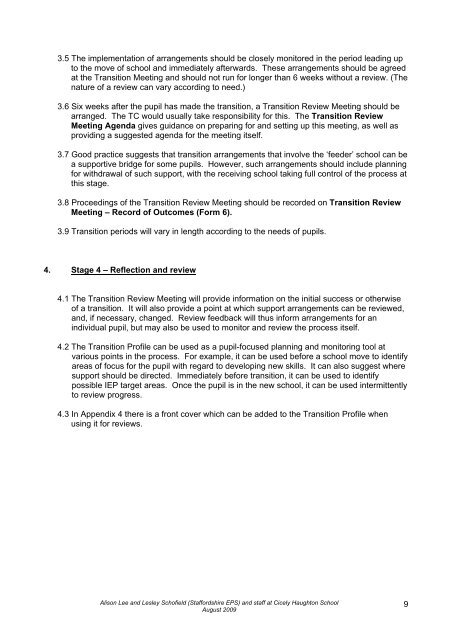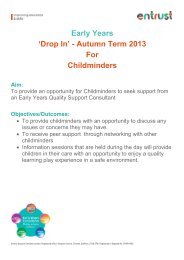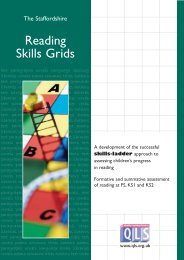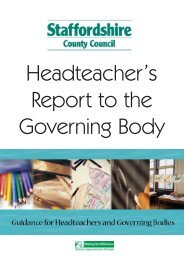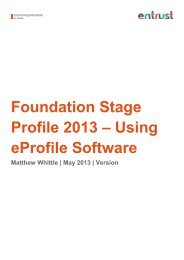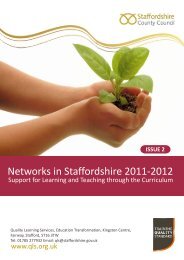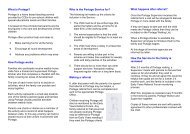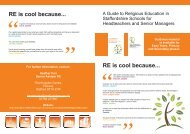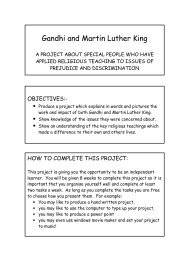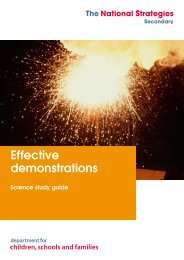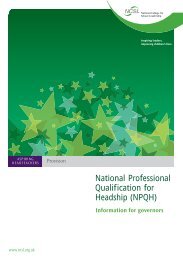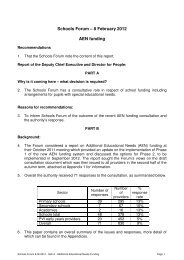Moving On: A Framework for Transitions - Staffordshire Learning Net ...
Moving On: A Framework for Transitions - Staffordshire Learning Net ...
Moving On: A Framework for Transitions - Staffordshire Learning Net ...
You also want an ePaper? Increase the reach of your titles
YUMPU automatically turns print PDFs into web optimized ePapers that Google loves.
3.5 The implementation of arrangements should be closely monitored in the period leading up<br />
to the move of school and immediately afterwards. These arrangements should be agreed<br />
at the Transition Meeting and should not run <strong>for</strong> longer than 6 weeks without a review. (The<br />
nature of a review can vary according to need.)<br />
3.6 Six weeks after the pupil has made the transition, a Transition Review Meeting should be<br />
arranged. The TC would usually take responsibility <strong>for</strong> this. The Transition Review<br />
Meeting Agenda gives guidance on preparing <strong>for</strong> and setting up this meeting, as well as<br />
providing a suggested agenda <strong>for</strong> the meeting itself.<br />
3.7 Good practice suggests that transition arrangements that involve the ‘feeder’ school can be<br />
a supportive bridge <strong>for</strong> some pupils. However, such arrangements should include planning<br />
<strong>for</strong> withdrawal of such support, with the receiving school taking full control of the process at<br />
this stage.<br />
3.8 Proceedings of the Transition Review Meeting should be recorded on Transition Review<br />
Meeting – Record of Outcomes (Form 6).<br />
3.9 Transition periods will vary in length according to the needs of pupils.<br />
4. Stage 4 – Reflection and review<br />
4.1 The Transition Review Meeting will provide in<strong>for</strong>mation on the initial success or otherwise<br />
of a transition. It will also provide a point at which support arrangements can be reviewed,<br />
and, if necessary, changed. Review feedback will thus in<strong>for</strong>m arrangements <strong>for</strong> an<br />
individual pupil, but may also be used to monitor and review the process itself.<br />
4.2 The Transition Profile can be used as a pupil-focused planning and monitoring tool at<br />
various points in the process. For example, it can be used be<strong>for</strong>e a school move to identify<br />
areas of focus <strong>for</strong> the pupil with regard to developing new skills. It can also suggest where<br />
support should be directed. Immediately be<strong>for</strong>e transition, it can be used to identify<br />
possible IEP target areas. <strong>On</strong>ce the pupil is in the new school, it can be used intermittently<br />
to review progress.<br />
4.3 In Appendix 4 there is a front cover which can be added to the Transition Profile when<br />
using it <strong>for</strong> reviews.<br />
Alison Lee and Lesley Schofield (Staf<strong>for</strong>dshire EPS) and staff at Cicely Haughton School<br />
August 2009<br />
9


